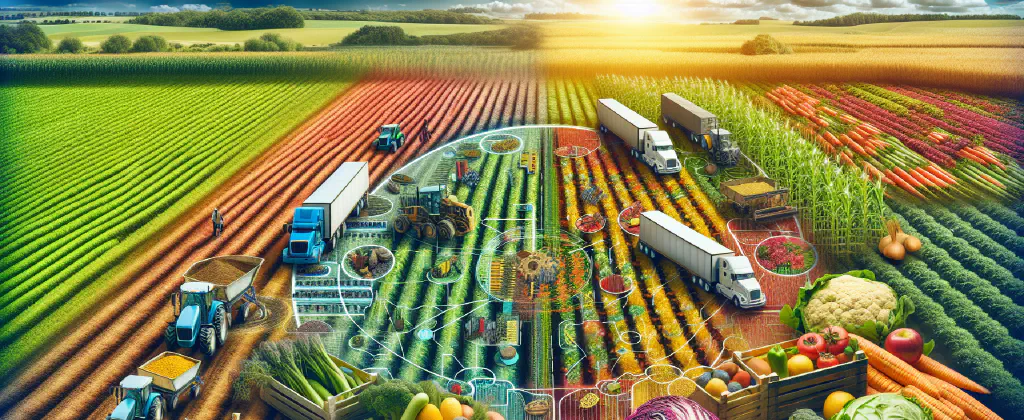16. December 2023
The Decline of Nutritional Value in Crops: Unveiling the Complex Factors

Our food is not as nutritious as it used to be. This is a concerning reality that has been gaining attention in recent years. The declining nutritional value of crops has raised questions about the impact of modern agricultural practices on the quality of our food. The issue is multifaceted, with several factors contributing to this phenomenon. From the depletion of soil nutrients to changes in agricultural practices and the impact of long-distance food transportation, the interconnected nature of our food system unveils a complex web of challenges.
The Soil-Nutrient Connection
One prominent factor in the declining nutritional value of crops is the depletion of soil nutrients. As crops are harvested from the soil without adequate measures to replenish nutrients, the overall fertility and nutrient content of the soil decline over time. This phenomena, well-known in organic farming circles, has been highlighted by organizations like the Rodale Institute. Most petroleum-based fertilizers used in industrial agriculture do not fully replenish the nutrient levels in the soil, leading to a gradual decay in soil health and subsequently, in the nutritional content of the derived food.
The Genetics and Growth Cycle Dilemma
However, the issue is not solely limited to soil health. The modern agricultural practices of breeding and selecting crops for specific characteristics have also played a role in the decline of nutritional value. While dwarf varieties and increased CO₂ levels have enabled crops to grow larger, the amount of nutrients these plants uptake from the soil has remained relatively constant. This means that larger plant sizes do not necessarily equate to increased nutrient content. Instead, they often result in diluted nutrients throughout the plant, leading to nutritionally anemic food.
Industrial Agriculture and Nutrient Imbalance
The industrial agriculture system, with its focus on high-volume production and shipping stability, has further intensified the problem. Fruits and vegetables are often selected based on their ability to withstand long-distance transportation and have a longer shelf life. These factors have led to the prioritization of qualities such as durability and appearance over taste and nutritional value. Tomatoes, for example, have undergone significant changes in flavor and nutritional content due to this selection process. The drive for uniformity and increased yield has led to the cultivation of varieties that lack the natural pigmentation and taste of their wild counterparts. This commercial focus on quantity over quality has contributed to the decrease in the nutritional value of our food.
The Complexity of Nutrient Interactions
It is important to note that the correlation between soil nutrients and food nutrients is not a straightforward one. As one commenter pointed out, what is nutritious to a human and to a plant may differ fundamentally. However, the availability of essential nutrients in the soil is a crucial prerequisite for their presence in the plants we consume. The lack of certain trace compounds in the soil can lead to gaps in the nutritional composition of the plants. For example, the absence of specific trace compounds can affect the synthesis of essential molecules in plants, leading to lower nutrient content in the final produce. This cascade effect highlights the importance of nutrient-rich soil for the nutritional value of crops.
A Call for Change and Solutions
Addressing the declining nutritional value of crops requires a holistic approach. Organic and regenerative agriculture practices have shown promise in replenishing soil nutrients and improving soil health. The focus shifts from solely feeding the crops to feeding and nourishing the soil itself. Practices such as crop rotation, green manure, and the integration of livestock can enhance biodiversity and restore soil fertility.
Furthermore, a shift towards localized food production can mitigate the impact of long-distance transportation and reduce carbon emissions. By growing food closer to population centers, we can reduce the time between harvest and consumption, ensuring fresher and potentially more nutritious food on our plates.
In conclusion, the declining nutritional value of crops is a complex issue rooted in the depletion of soil nutrients, changes in agricultural practices, and the influence of industrial agriculture. Addressing this challenge requires a multi-faceted approach that includes sustainable farming practices, localized food production, and a shift towards prioritizing nutrient-rich soil. By understanding the interconnected factors affecting the nutritional value of our food, we can work towards a more sustainable and nourishing food system.
Source: https://jeroenvanbaar.substack.com/p/data-dispatch-4-the-falling-nutritional